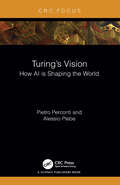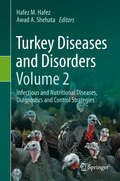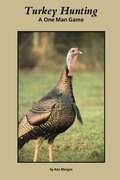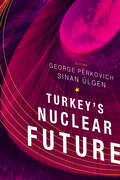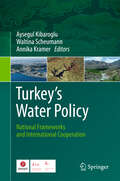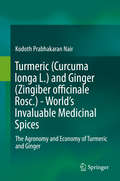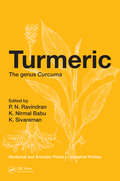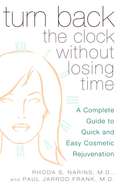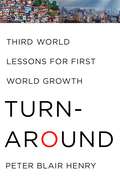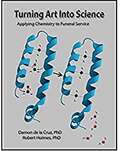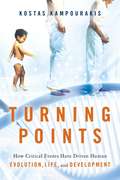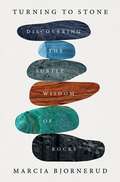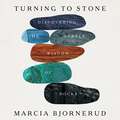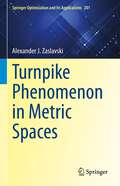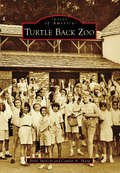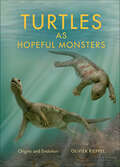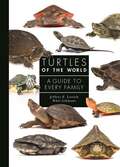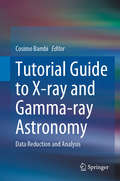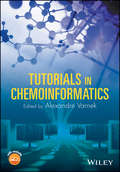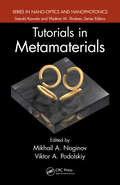- Table View
- List View
Turing's Vision: How AI is Shaping the World
by Pietro Perconti Alessio PlebeChat-GPT, humanoid robotics, and self-driving cars are just a few of the things that are changing our everyday lives. The rapid advancement of AI is eroding one by one all the cornerstones considered unique of human nature: language, consciousness, creativity, and moral responsibility. The book argues that the revolution we are facing is driven by Alan Turing's "vision". This vision rests on the idea that intelligence is not an intrinsic property of human beings, but is a way in which matter is functionally organized and an attribute we are naturally inclined to ascribe to certain entities. For decades we have pretended that this idea does not have the corrosive power that it actually does, perhaps more so than the Copernican and Darwinian revolutions. But now, given the achievements of new forms of computing based on deep learning and predictive coding, the most common intuitions can no longer avoid the dangerous Turing idea.The book is intended for scholars, researchers, and readers intrigued by the intersections across disciplines interested in understanding the philosophical, ethical, and social implications of Artificial Intelligence and its impact on human nature.
Turkana Boy
by Jessica Moore Jean-François BeaucheminIn this contemplative novel-poem, Jean-François Beauchemin invites us to share in the inner world of the grieving Mr. Bartolomé, who, following the mysterious disappearance of his young son, wanders and wonders, seeking to transcend his pain by encountering something larger than himself. Continuously occupied by the memory of his lost son, Bartolomé's quest leads him from the city to the countryside and then to the edge of the ocean, where he marvels at the beauty of nature but cannot penetrate its mysteries.Through reference to the two-million-year-old "Turkana Boy," the fossilized remains of a boy found in 1984 near Lake Turkana, Kenya, Beauchemin addresses processes of memory and the long history of human evolution. Beauchemin's character Bartolomé sees in the lives of the boys-separated by nearly two million years-a kind of twin destiny. Has the passage of millennia changed the intensity of human feeling at the loss of blood relations? "Who knows what they had felt? Had the same emotions, those associated with incommensurable loss, broken their bodies, as they had his? Over and above morphological differences sculpted by the passage of millennia, was there something resembling a permanence of feeling, a sort of eternity for the murmuring of the heart, transmitted through the ages by the bonds of blood?"Turkana Boy offers a poignant examination of grieving and one man's search for understanding. This surrealist narrative is punctuated with magnificent musings on the world and startling questions about what it means to be alive.
Turkey Diseases and Disorders Volume 2: Infectious and Nutritional Diseases, Diagnostics and Control Strategies
by Hafez M. Hafez Awad A. ShehataThis volume 2 of a two-volume work provides an overview of the current state of knowledge on the most common viral and parasitic diseases in turkeys. Each chapter is dedicated to a specific infectious disease and provides information on pathogenesis, symptoms and therapeutic strategies. The book also addresses nutritional diseases in fattening turkeys, and introduces diagnostic techniques as well as disease prevention and control strategies. The clear and structured layout allows the reader to refer to it quickly. This book is an indispensable guide for veterinarians, researchers and professionals working in turkey production and health.
Turkey Hunting: A One Man Game
by Kenny Morgan William YarbroughTURKEY HUNTING, A ONE MAN GAME, by Ken Morgan, is a hardback, color edition (1987) that recalls a lifetime of hunting lessons. This turkey hunting book lays out some blueprints for all aspects of wild turkey hunting and sprinkles the reader with generous doses of facts. <p><p>The author has also included a memorization chart that details the best turkey calling sounds to make in each hunting circumstance, and the area of our attitudes and values in turkey hunting is addressed. In addition, the author's appealing storytelling style, as well as his well-founded observations and insights into wild turkey behavior and biology, make Kenny Morgan's book one that you will want to read again and again.
Turkey's Nuclear Future
by Sinan Ülgen George PerkovichTurkey, with a robust modern economy and growing energy needs, is pursuing a switch to nuclear power. But that shift is occurring in an environment fraught with security challenges: Turkey borders Iraq, Syria, and Iran-all states with nuclear or WMD ambitions or capabilities. As a NATO member, Turkey also hosts U.S. nuclear bombs on its territory, although some question the durability of this relationship. This dynamic has naturally led to speculation that Turkish leaders might someday consider moving beyond a civilian course to develop nuclear weapons. Yet there has been remarkably little informed analysis and debate on Turkey's nuclear future, either within the country or in broader international society. This volume explores the current status and trajectory of Turkey's nuclear program, adding historical perspective, analytical rigor, and strategic insight.
Turkey's Water Policy: National Frameworks and International Cooperation
by Annika Kramer Waltina Scheumann Aysegul KibarogluWater is a strategic natural resource of vital importance to all nations. As such it has been the cause of several international disputes. For Turkey especially, water is crucial to social and economic development. Turkey's current national water regime that emphasises water resources development and management for productive uses, however, faces growing environmental concerns and international criticism regarding transboundary water cooperation. Furthermore, EU accession requires Turkey to adopt an extensive and ambitious body of EU water law. To understand Turkey's position to international water law, the national policies and socio-economic circumstances that impact water resources management need to be considered. This book fills the existing knowledge gap through a broad perspective and analysis of the current state of Turkey's water policy and its management of both national and transboundary waters. It is a unique undertaking that brings together Turkish and international authors, practitioners and academics, covering all aspects of water management
Turmeric (Curcuma longa L.) and Ginger (Zingiber officinale Rosc.) - World's Invaluable Medicinal Spices: The Agronomy and Economy of Turmeric and Ginger
by Kodoth Prabhakaran NairThis book discusses the various aspects, from production to marketing of turmeric and ginger, the world’s two most important and invaluable medicinal spice crops. The book begins with their origin and history, global spread, and goes on to describe the botany, production agronomy, fertilizer practices, pest management, post-harvest technology, pharmacology and nutraceutical uses. The book presents the economy, import-export and world markets involved with reference to turmeric and ginger. It would be a benchmark and an important reference source for scientists, students, both undergraduate and post graduate, studying agriculture and food sciences and policy makers. It would be of great interest to professionals and industry involved in spice trade.
Turmeric: The genus Curcuma (Medicinal and Aromatic Plants - Industrial Profiles)
by P. N. Ravindran K. Nirmal Babu K. SivaramanFor the last 6000 years turmeric has been used in Ayurvedic medicine to alleviate pain, balance digestion, purify body and mind, clear skin diseases, expel phlegm, and invigorate the blood. Nowadays, this plant has acquired great importance with its anti-aging, anti-cancer, anti-Altzheimer, antioxidant, and a variety of other medicinal properties.
Turn Back the Clock Without Losing Time: A Complete Guide to Quick and Easy Cosmetic Rejuvenation
by Rhoda S. Narins Paul Jarrod FrankPut Your Best Face Forward--at Any Age Written by two of America's top dermatologists,Turn Back the Clock Without Losing Time is the ultimate guide to the exciting new procedures that can dramatically improve your appearance with minimal or no recovery time. Treatments discussed include: Physical and Chemical Peels Laser Treatments Collagen and Other Fillers, Botox,Liposuction, Eyelifts, Hair Restoration, Varicose Vein Treatments, Skin Care. With informative before-and-after line drawings, expert advice, and sensitive answers to frequently asked questions, Turn Back the Clock Without Losing Time is a must-have for anyone considering cosmetic surgery.
Turn Left at Orion
by Guy Consolmagno Dan M. DavisA superb guidebook described in Bookwatch as 'the home astronomer's "bible"', Turn Left at Orion provides all the information beginning amateur astronomers need to observe the Moon, the planets and a whole host of celestial objects. Large format diagrams show these objects exactly as they appear in a small telescope and for each object there is information on the current state of our astronomical knowledge. Revised and updated, this new edition contains a chapter with ten new spreads describing spectacular deep sky objects visible from the southern hemisphere, and tips on observing the upcoming transits of Venus. It also discusses Dobsonian telescopes, with hints on using personal computers and the Internet as aids for planning an observing session. Also new to this edition are redrawn "Guidepost" figures at the beginning of each season chapter that allow readers to visualize a three-dimensional view of the sky's dome; redesigned seasonal object layouts that provide more space for the naked-eye charts; a new spread on double stars near Bo_tes has been added to Spring, replacing the "Shrinking Double" spread; and a unique "When and Where to Look" table has been added to the last page, among other new features. Unlike many guides to the night sky, this book is specifically written for observers using small telescopes. Clear and easy to use, this fascinating book will appeal to skywatchers of all ages and backgrounds. No previous knowledge of astronomy is needed.
Turn Right At Orion
by Mitchell BegelmanTurn Right at Orion is the account of an epic astronomical journey, discovered sixty million years in Earth's future-the product of one man's amazing, revelatory, and occasionally perilous space odys
Turnaround: Third World Lessons for First World Growth
by Peter Blair HenryThirty years ago, China seemed hopelessly mired in poverty, Mexico triggered the Third World Debt Crisis, and Brazil suffered under hyperinflation. Since then, these and other developing countries have turned themselves around, while First World nations, battered by crises, depend more than ever on sustained growth in emerging markets. In "Turnaround," economist Peter Blair Henry argues that the secret to emerging countriesOCO success (and ours) is disciplineOCosustained commitment to a pragmatic growth strategy. With the global economy teetering on the brink, the stakes are higher than ever. And because stakes are so high for all nations, we need less polarization and more focus on facts to answer the fundamental question: which policy reforms, implemented under what circumstances, actually increase economic efficiency? Pushing past the tired debates, Henry shows that the stock marketOCOs forecasts of policy impact provide an important complement to traditional measures. Through examples ranging from the drastic income disparity between Barbados and his native Jamaica to the OC catch upOCO economics of China and the taming of inflation in Latin America, Henry shows that in much of the emerging world the policy pendulum now swings toward prudence and self-control. With similar discipline and a dash of humility, he concludes, the First World may yet recover and create long-term prosperity for all its citizens. Bold, rational, and forward-looking, "Turnaround" offers vital lessons for developed and developing nations in search of stability and growth.
Turning Art Into Science: Applying Chemistry to Funeral Service
by PhD Damon de la Cruz PhD Robert HolmesTurning Art Into Science: Applying Chemistry to Funeral Service
Turning Points: How Critical Events Have Driven Human Evolution, Life, And Development
by Kostas KampourakisAn accessible introduction to core concepts in evolution for lay readers, which shows that random events have played a critical role in the development of lifeCritical historical events--or "turning points"--have shaped evolution and continue to have a decisive effect on individual lives. This theme is explored and explained in this lucid, accessible book for lay readers. The author argues that, although evolution is the result of unpredictable events, these events have profound influences on subsequent developments. Life is thus a continuous interplay between unforeseeable events and their decisive consequences.As one example, the author cites the fusing of two chromosomes, which differentiated the human species from our closest animal relatives about 4 to 5 million years ago. This event was not predictable, but it had a profound effect on the evolution of our species thereafter. By the same token, certain unpredictable circumstances in the past enabled only Homo sapiens to survive to the present day, though we now know that other human-like species also once existed.The author contrasts such scientific concepts grounded in solid evidence with prevalent misconceptions about life: specifically, the religious notion that there is a plan and purpose behind life, the widespread perception that intelligent design governs the workings of nature, the persistent belief in destiny and fate, and the attribution of an overly deterministic role to genes.This excellent introduction for laypersons to core ideas in biology goes a long way toward dispelling such misconceptions and presents current scientific research in clearly understandable, jargon-free terms.
Turning to Stone
by Marcia Bjornerud'A nuanced celebration of the language of stone' DAVID GEORGE HASKELL'A unique and timeless book' ROBERT HALZENRocks are the record of our creative planet reinventing itself for four billion years. Nothing is ever lost, just transformed. Marcia Bjornerud's life as a geologist has coincided with an extraordinary period of discovery. From an insular girlhood in rural Wisconsin, she found her way to an unlikely career studying mountains in remote parts of the world. As one of few women in her field, she witnessed the shift in our understanding of the Earth, from solid object to an entity in a constant state of transformation. In the most tumultuous times of her own life, a deep understanding of our rocky planet imbued her life with meaning.The lives of rocks are long and complex, spanning billions of years and yet shaping our own human lives in powerful, invisible ways. Sandstone that filters out pathogens creating underground oases in aquifers of clean water. Ecologite is "the chosen rock" whose formation keeps the planet running. Earth is not just a passive backdrop, or a source of resources to be mined, extracted, and carved out. Rocks are full of wisdom, but somewhere along the way many of us have forgotten how to hear it.When we are uncertain about where to find truth, a geocentric worldview reminds us that we are Earthlings, part of a planetary community where we can find wisdom in the most unlikely places.
Turning to Stone
by Marcia Bjornerud'A nuanced celebration of the language of stone' DAVID GEORGE HASKELL'A unique and timeless book' ROBERT HALZENRocks are the record of our creative planet reinventing itself for four billion years. Nothing is ever lost, just transformed. Marcia Bjornerud's life as a geologist has coincided with an extraordinary period of discovery. From an insular girlhood in rural Wisconsin, she found her way to an unlikely career studying mountains in remote parts of the world. As one of few women in her field, she witnessed the shift in our understanding of the Earth, from solid object to an entity in a constant state of transformation. In the most tumultuous times of her own life, a deep understanding of our rocky planet imbued her life with meaning.The lives of rocks are long and complex, spanning billions of years and yet shaping our own human lives in powerful, invisible ways. Sandstone that filters out pathogens creating underground oases in aquifers of clean water. Ecologite is "the chosen rock" whose formation keeps the planet running. Earth is not just a passive backdrop, or a source of resources to be mined, extracted, and carved out. Rocks are full of wisdom, but somewhere along the way many of us have forgotten how to hear it.When we are uncertain about where to find truth, a geocentric worldview reminds us that we are Earthlings, part of a planetary community where we can find wisdom in the most unlikely places.
Turnpike Phenomenon in Metric Spaces (Springer Optimization and Its Applications #201)
by Alexander J. ZaslavskiThis book is devoted to the study of the turnpike phenomenon arising in optimal control theory. Special focus is placed on Turnpike results, in sufficient and necessary conditions for the turnpike phenomenon and in its stability under small perturbations of objective functions. The most important feature of this book is that it develops a large, general class of optimal control problems in metric space. Additional value is in the provision of solutions to a number of difficult and interesting problems in optimal control theory in metric spaces. Mathematicians working in optimal control, optimization, and experts in applications of optimal control to economics and engineering, will find this book particularly useful.All main results obtained in the book are new. The monograph contains nine chapters. Chapter 1 is an introduction. Chapter 2 discusses Banach space valued functions, set-valued mappings in infinite dimensional spaces, and related continuous-time dynamical systems. Some convergence results are obtained. In Chapter 3, a discrete-time dynamical system with a Lyapunov function in a metric space induced by a set-valued mapping, is studied. Chapter 4 is devoted to the study of a class of continuous-time dynamical systems, an analog of the class of discrete-time dynamical systems considered in Chapter 3. Chapter 5 develops a turnpike theory for a class of general dynamical systems in a metric space with a Lyapunov function. Chapter 6 contains a study of the turnpike phenomenon for discrete-time nonautonomous problems on subintervals of half-axis in metric spaces, which are not necessarily compact. Chapter 7 contains preliminaries which are needed in order to study turnpike properties of infinite-dimensional optimal control problems. In Chapter 8, sufficient and necessary conditions for the turnpike phenomenon for continuous-time optimal control problems on subintervals of the half-axis in metric spaces, is established. In Chapter 9, the examination continues of the turnpike phenomenon for the continuous-time optimal control problems on subintervals of half-axis in metric spaces discussed in Chapter 8.
Turtle Back Zoo (Images of America)
by Brint Spencer Caitlin A. SharpWith 140 animals of 40 species, the Turtle Back Zoo opened in 1963 as a seasonal children's zoo. The community and county government brought the zoo to life, while the Essex County Park Commission administered its daily functions. With funds generated from the sale of land for highway development, architects and builders selected a fairy tale, Hans Christian Andersen aesthetic for their theme. Once opened, Turtle Back Zoo was an instant success, and its popularity led to it becoming a year-round attraction that appealed to all ages. The family recreation experience came to include wildlife conservation education as well. In the early 2000s, the zoo was renovated, and a first-class animal hospital was built to serve the growing animal collection. The site is now recognized as a first-rate, modern zoo and is accredited by the Association of Zoos & Aquariums.
Turtles (Readers)
by Laura MarshTake a dip with turtles in this exciting reader. Packed with beautiful and engaging photos, kids will learn all about these fantastic reptiles. This level 1 reader is carefully leveled for an early independent reading or read aloud experience, perfect to encourage the scientists and explorers of tomorrow!
Turtles as Hopeful Monsters: Origins and Evolution (Life of the Past)
by Olivier RieppelWhere do turtles hail from? Why and how did they acquire shells? These questions have spurred heated debate and intense research for more than two hundred years. Brilliantly weaving evidence from the latest paleontological discoveries with an accessible, incisive look at different theories of biological evolution and their proponents, Turtles as Hopeful Monsters tells the fascinating evolutionary story of the shelled reptiles. Paleontologist Olivier Rieppel traces the evolution of turtles from over 220 million years ago, examining closely the relationship of turtles to other reptiles and charting the development of the shell. Turtle issues fuel a debate between proponents of gradual evolutionary change and authors favoring change through bursts and leaps of macromutation. The first book-length popular history of its type, this indispensable resource is an engaging read for all those fascinated by this ubiquitous and uniquely shaped reptile.
Turtles of Mexico
by John Legler Richard C. VogtThe Turtles of Mexico is the first comprehensive guide to the biology, ecology, evolution, and distribution of more than fifty freshwater and terrestrial turtle taxa found in Mexico. Legler and Vogt draw on more than fifty years of fieldwork to elucidate the natural history of these species. The volume includes an extensive introduction to turtle anatomy, taxonomy, phylogeny, biogeography, and physiology. A key to the turtles of Mexico is included along with individual species accounts featuring geographic distribution maps and detailed color illustrations. Specific topics discussed for each species include habitat, diet, feeding behavior, reproduction, predators, parasites, growth and ontogeny, sexual dimorphism, growth rings, economic use, conservation, legal protection, and taxonomic studies. This book is a complete reference for scientists, conservationists, and professional and amateur enthusiasts who wish to study Mexican turtles.
Turtles of the World: A Guide to Every Family
by Whit Gibbons Jeffrey E. LovichA lavishly illustrated guide to the world's turtles that covers every family and genusTurtles of the World reveals the extraordinary diversity of these amazing reptiles. Characterized by the bony shell that acts as a shield to protect the softer body within, turtles are survivors from the time of the dinosaurs and are even more ancient in evolutionary terms than snakes and crocodilians. Of more than 350 species known today, some are highly endangered. In this beautiful guide, turtle families, subfamilies, and genera are illustrated with hundreds of color photographs. Each genus profile includes a population distribution map, a table of information, and commentary that includes notable characteristics and discussion of related species.More than 250 beautiful color photosEach profile features a distribution map, table of information, and commentaryBroad coverage includes every family and genus
Tutorial Guide to X-ray and Gamma-ray Astronomy: Data Reduction and Analysis
by Cosimo BambiThis book provides a comprehensive introduction to X-ray and gamma-ray astronomy. The first part discusses the basic theoretical and observational topics related to black hole astrophysics; the optics and the detectors employed in X-ray and gamma-ray astronomy; and past, present, and future X-ray and gamma-ray missions. The second part then describes data reduction and analysis, the statistics used in X-ray and gamma-ray astronomy, and demonstrates how to write a successful proposal and a scientific paper. Data reduction in connection with specific X-ray and gamma-ray missions is covered in the appendices. Presenting the state of the art in X-ray and gamma-ray astronomy, this is both a valuable textbook for students and an important reference resource for researchers in the field.
Tutorials in Chemoinformatics
by Alexandre Varnek30 tutorials and more than 100 exercises in chemoinformatics, supported by online software and data sets Chemoinformatics is widely used in both academic and industrial chemical and biochemical research worldwide. Yet, until this unique guide, there were no books offering practical exercises in chemoinformatics methods. Tutorials in Chemoinformatics contains more than 100 exercises in 30 tutorials exploring key topics and methods in the field. It takes an applied approach to the subject with a strong emphasis on problem-solving and computational methodologies. Each tutorial is self-contained and contains exercises for students to work through using a variety of software packages. The majority of the tutorials are divided into three sections devoted to theoretical background, algorithm description and software applications, respectively, with the latter section providing step-by-step software instructions. Throughout, three types of software tools are used: in-house programs developed by the authors, open-source programs and commercial programs which are available for free or at a modest cost to academics. The in-house software and data sets are available on a dedicated companion website. Key topics and methods covered in Tutorials in Chemoinformatics include: Data curation and standardization Development and use of chemical databases Structure encoding by molecular descriptors, text strings and binary fingerprints The design of diverse and focused libraries Chemical data analysis and visualization Structure-property/activity modeling (QSAR/QSPR) Ensemble modeling approaches, including bagging, boosting, stacking and random subspaces 3D pharmacophores modeling and pharmacological profiling using shape analysis Protein-ligand docking Implementation of algorithms in a high-level programming language Tutorials in Chemoinformatics is an ideal supplementary text for advanced undergraduate and graduate courses in chemoinformatics, bioinformatics, computational chemistry, computational biology, medicinal chemistry and biochemistry. It is also a valuable working resource for medicinal chemists, academic researchers and industrial chemists looking to enhance their chemoinformatics skills.
Tutorials in Metamaterials (Series in Nano-Optics and Nanophotonics)
by Mikhail A. Noginov Viktor A. PodolskiyFrom science fiction to science laboratoriesDiscover the State of the Art in Photonic MetamaterialsMetamaterials-composite media with unusual optical properties-have revolutionized the landscape of optical science and engineering over the past decades. Metamaterials have transformed science-fiction-like concepts of superresolution imaging and optic
